Time-irreversible subconductance gating associated with Ba2+ block of large conductance Ca2+-activated K+ channels
- PMID: 9450947
- PMCID: PMC2222771
- DOI: 10.1085/jgp.111.2.343
Time-irreversible subconductance gating associated with Ba2+ block of large conductance Ca2+-activated K+ channels
Abstract
Ba2+ block of large conductance Ca2+-activated K+ channels was studied in patches of membrane excised from cultures of rat skeletal muscle using the patch clamp technique. Under conditions in which a blocking Ba2+ ion would dissociate to the external solution (150 mM N-methyl-D-glucamine+o, 500 mM K+i, 10 microM Ba2+i, +30 mV, and 100 microM Ca2+i to fully activate the channel), Ba2+ blocks with a mean duration of approximately 2 s occurred, on average, once every approximately 100 ms of channel open time. Of these Ba2+ blocks, 78% terminated with a single step in the current to the fully open level and 22% terminated with a transition to a subconductance level at approximately 0.26 of the fully open level (preopening) before stepping to the fully open level. Only one apparent preclosing was observed in approximately 10,000 Ba2+ blocks. Thus, the preopenings represent Ba2+-induced time-irreversible subconductance gating. The fraction of Ba2+ blocks terminating with a preopening and the duration of preopenings (exponentially distributed, mean = 0.75 ms) appeared independent of changes in [Ba2+]i or membrane potential. The fractional conductance of the preopenings increased from 0.24 at +10 mV to 0.39 at +90 mV. In contrast, the average subconductance level during normal gating in the absence of Ba2+ was independent of membrane potential, suggesting different mechanisms for preopenings and normal subconductance levels. Preopenings were also observed with 10 mM Ba2+o and no added Ba2+i. Adding K+, Rb+, or Na+ to the external solution decreased the fraction of Ba2+ blocks with preopenings, with K+ and Rb+ being more effective than Na+. These results are consistent with models in which the blocking Ba2+ ion either induces a preopening gate, and then dissociates to the external solution, or moves to a site located on the external side of the Ba2+ blocking site and acts directly as the preopening gate.
Figures

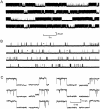


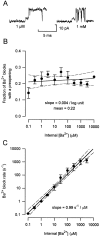
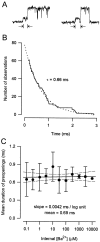

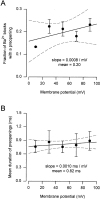




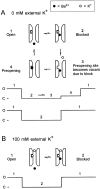

References
-
- Armstrong, C.M. 1975. Potassium pores of nerve and muscle membranes. In Membranes. Volume 3. G. Eisenman, editor. Marcel Dekker, Inc. New York. 325–357. - PubMed
Publication types
MeSH terms
Substances
Grants and funding
LinkOut - more resources
Full Text Sources
Miscellaneous

